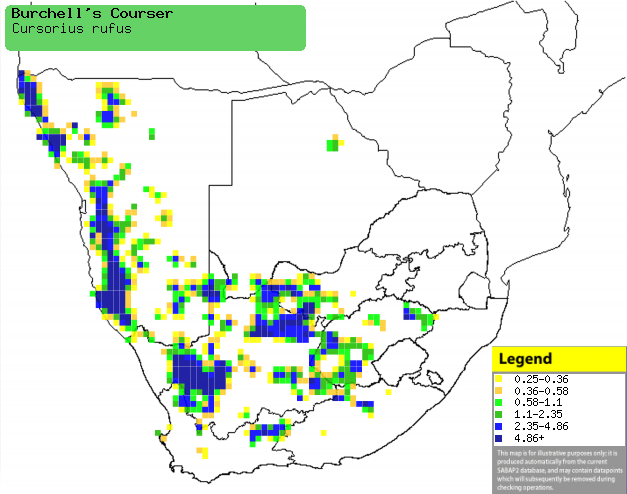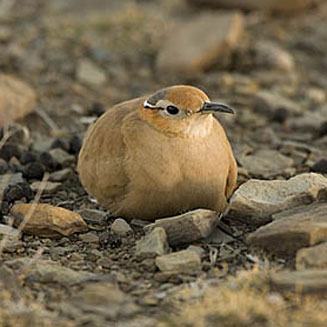|
Cursorius rufus (Burchell's
courser)
Bloukopdrawwertjie [Afrikaans]; Ingegane, Ucelithafa
[Xhosa]; uNobulongwe (generic term for courser) [Zulu]; Mokopjoane [South
Sotho]; Rosse renvogel [Dutch]; Courvite de Burchell [French]; Rostrennvogel
[German]; Corredor de Burchell [Portuguese]
Life
> Eukaryotes >
Opisthokonta
> Metazoa (animals) >
Bilateria >
Deuterostomia > Chordata >
Craniata > Vertebrata (vertebrates) > Gnathostomata (jawed
vertebrates) > Teleostomi (teleost fish) > Osteichthyes (bony fish) > Class:
Sarcopterygii (lobe-finned
fish) > Stegocephalia (terrestrial
vertebrates) > Tetrapoda
(four-legged vertebrates) > Reptiliomorpha > Amniota >
Reptilia (reptiles) >
Romeriida > Diapsida > Archosauromorpha > Archosauria >
Dinosauria
(dinosaurs) > Saurischia > Theropoda (bipedal predatory dinosaurs) >
Coelurosauria > Maniraptora > Aves
(birds) > Order: Charadriiformes
> Family: Glareolidae
Distribution and habitat
Near-endemic to southern Africa, occurring from
south-western Angola through Namibia to the Northern Cape and adjacent
provinces, as well as southern Botswana. It generally prefers open, sparsely
vegetated areas, such as heavily grazed or burnt grasslands, Karoo, stony and
gravelly semi-desert, bare or slightly grassy pans, ploughed fields, emergent
cereal crops and rarely coastal dunes.
|
 |
|
Distribution of Burchell's courser in southern Africa,
based on statistical smoothing of the records from first SA Bird Atlas
Project (©
Animal Demography unit, University of
Cape Town; smoothing by Birgit Erni and Francesca Little). Colours range
from dark blue (most common) through to yellow (least common).
See here for the latest distribution
from the SABAP2. |
Movements and migrations
Nomadic and locally migratory, although its
movements are not well understood; it is thought to be a summer
visitor in the north and a winter visitor to the
south-west.
Food
It mainly eats insects, doing most of its foraging by
repeatedly
running 6-10 steps, then pausing to search for prey to be plucked from the ground or
dug out from the soil. The following food items have been recorded
in its diet:
- Insects
-
termites
- Hodotermes mossambicus (Northern harvester termites)
- Coleoptera
(beetles and weevils)
- ants
Breeding
- Monogamous, solitary breeder, probably with a long pair bond.
- It does not build a nest, instead laying its eggs on bare ground (such
as in the photo below), often between grass tufts or some other disruptive
object.
 |
|
|
Burchell's courser incubating its eggs,
Cyferfontein, Springfontein, South Africa. [photo Warwick Tarboton ©] |
|
- Egg-laying usually starts after rainfall in the north-west and before
rainfall further south, peaking from June-November.
- It lays 1-2 eggs, which are incubated by both sexes for at least 25
days.
- The chicks leave the nest within 8 hours of hatching, crouching low when
their parents warn them of a predator's presence.
Threats
Not threatened, although its range and population have
markedly decreased in the past 150 years, the cause of which is not well understood.
It is mostly likely due to the spread of agriculture across its favoured
habitats.
References
-
Hockey PAR, Dean WRJ and Ryan PG 2005. Roberts
- Birds of southern Africa, VIIth ed. The Trustees of the John Voelcker
Bird Book Fund, Cape Town.
|
